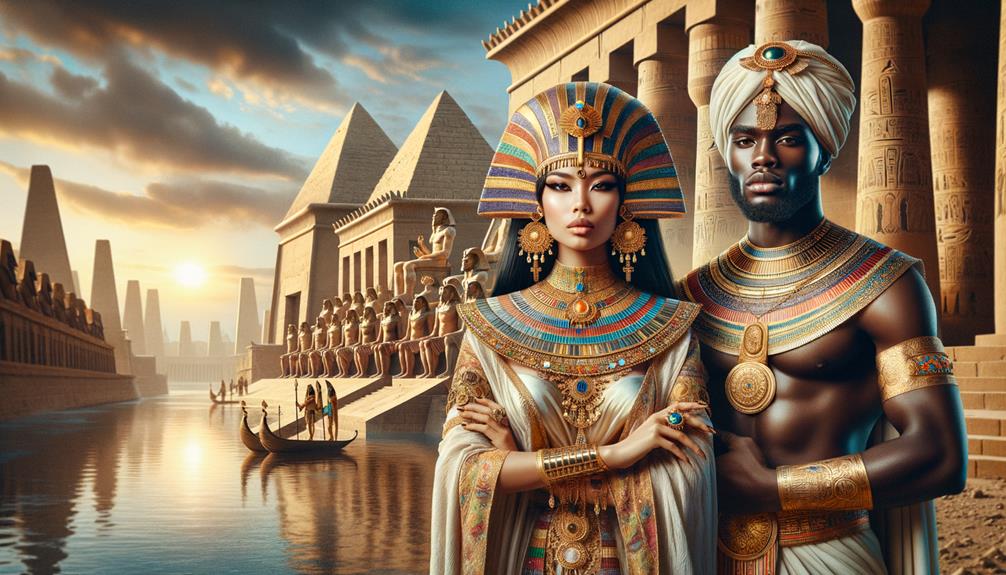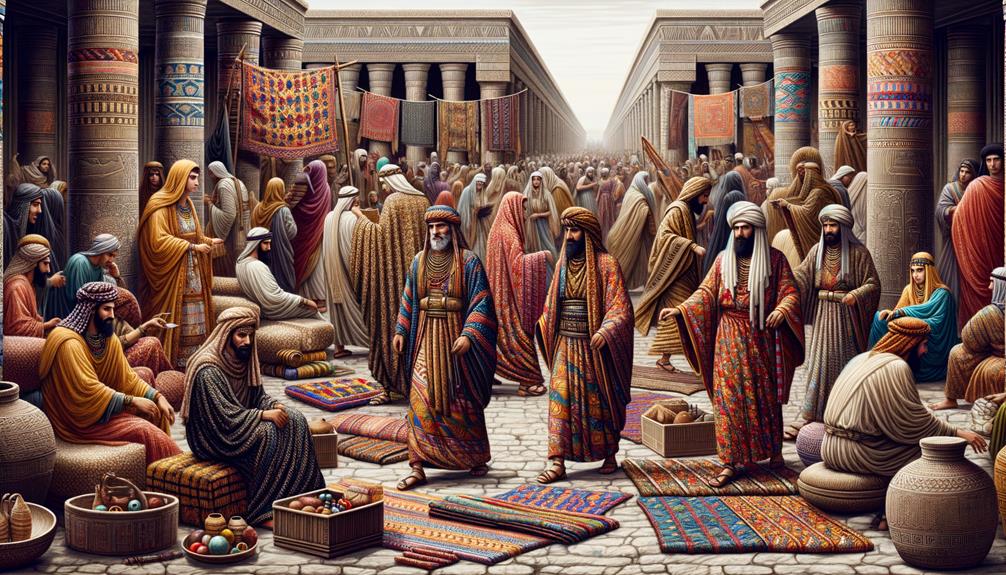I often find myself pondering the intricate designs and luxurious fabrics of Ancient Chinese fashion, wondering if they were more than just a reflection of social status – perhaps a silent dialogue between the wearer and the cosmos. As I observe the evolution from the Neolithic Age's humble hemp to the Shang Dynasty's opulent silks, I feel a deep connection to the past, a yearning to understand the stories woven into each garment. The interplay of tradition and innovation in their attire hints at a civilization that revered both the fleeting and the eternal. What secrets might these ancient threads still hold?
Clothing of the Neolithic Age
In the Neolithic Age of ancient China, the humble clothing made from hemp and ramie fibers reveals a story of early ingenuity and social hierarchy. As I reflect on this era, I see how the fabric of daily life was intertwined with the plant fibers that clothed early communities. These textiles, though simple, were crafted with a purpose, their simplicity echoing the agricultural rhythms of the time.
Clothing wasn't just about protection; it was a canvas for natural dyes, where plant-based pigments brought a splash of color to the otherwise earthy tones. I imagine the vibrant hues that adorned these garments, each color telling its own story of local flora and creativity. Patterns emerged, simple yet profound, reflecting both individual and communal identities.
Beyond aesthetics, these garments played a significant role in defining social roles and status. A finely woven piece of hemp could signify more than just skill – it marked one's place within the social fabric.
Animal skins and furs were also utilized, showcasing a resourceful blend of materials. This mix of plant and animal-derived clothing highlights a resourceful and adaptive culture, one where every element had its place and purpose.
Fashion in the Shang Dynasty
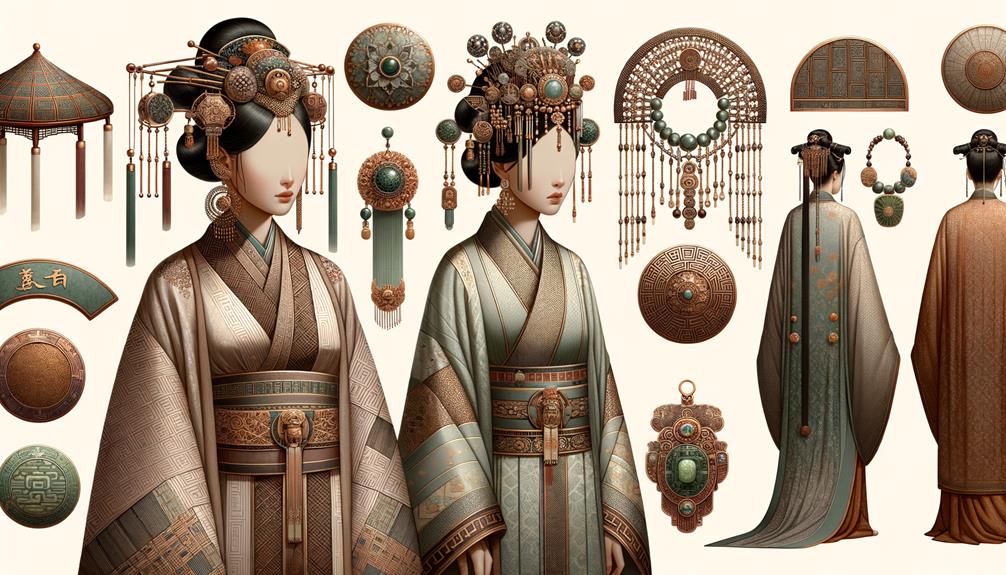
Exploring the fashion of the Shang Dynasty, I'm struck by the luxurious silks and intricate embroidery that defined an era of opulence and strict social codes. Clothing during this period wasn't just about covering the body; it was a visual representation of one's social status and reverence for tradition.
The use of silk, wool, and hemp materials created a rich tapestry of textures. Silk, in particular, was reserved for the elite, shimmering under the light as a symbol of wealth. Bronze decorations and jade accessories added layers of sophistication, their cool surfaces contrasting with the warm, flowing fabrics. Each piece of clothing seemed to tell a story, woven with threads of history and culture.
Embroidery wasn't merely decorative; it conveyed the wearer's place in society. Intricate patterns and symbolic motifs spoke volumes about one's position and responsibilities. Women's clothing typically featured long skirts and robes, each stitch and fold meticulously crafted. Shang Dynasty fashion was a visual language, conveying complex social information.
In this era, clothing went beyond mere attire – it was a representation of identity.
Styles of the Western Zhou
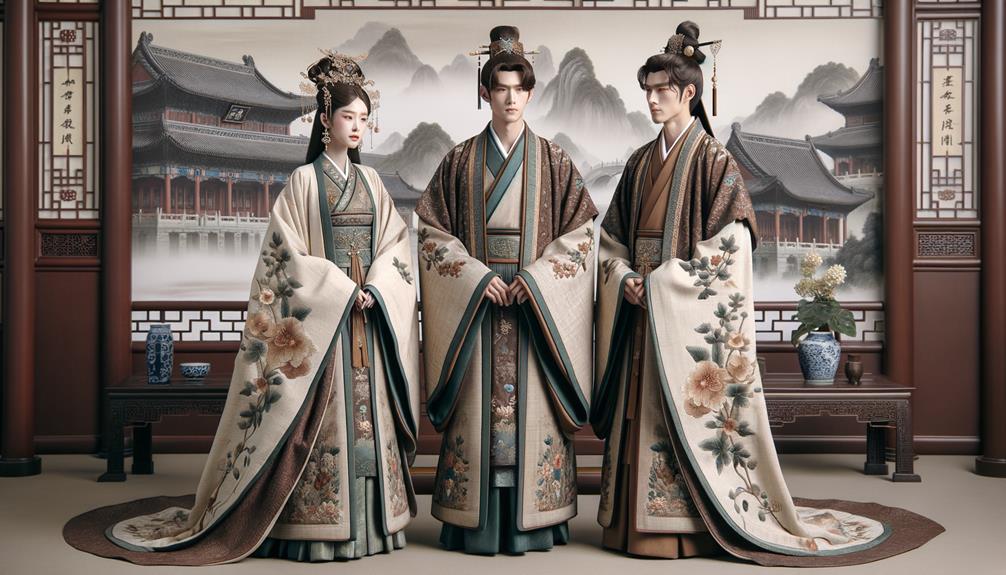
The Western Zhou dynasty's fashion was a deliberate reflection of its complex social hierarchy. Each layer of clothing told a story of status and rank, creating a visual distinction between the elite and the common folk. The ruling class, draped in robes adorned with intricate embroidery, exuded authority. Their garments, woven from fine silks, were masterpieces of craftsmanship, symbolizing the power they wielded.
In contrast, the simpler attire of commoners, fashioned from hemp or coarse silk, spoke of a life grounded in practicality. Yet, even within these humble fabrics, the essence of Chinese ingenuity was evident. The distinction between the classes wasn't just in the threads they wore, but in the very colors and designs that were strictly regulated to maintain social order.
Accessories played a pivotal role in this ancient fashion narrative. Jade ornaments and belt hooks were not mere embellishments but powerful symbols of hierarchical status. Each element, from the subtle hues to the elaborate patterns, was a deliberate expression of one's place within the societal structure.
The social hierarchy was evident in the fabrics and embellishments used:
Ruling Class: Fine Silk, Intricate Embroidery
Aristocrats: High-Quality Silk, Detailed Patterns
Commoners: Coarse Silk, Minimalist Embroidery
Peasants: Hemp, Simple Designs
As I ponder these ancient styles, I see a world where fashion was not just aesthetic but a language of power and position.
Qin Dynasty Attire
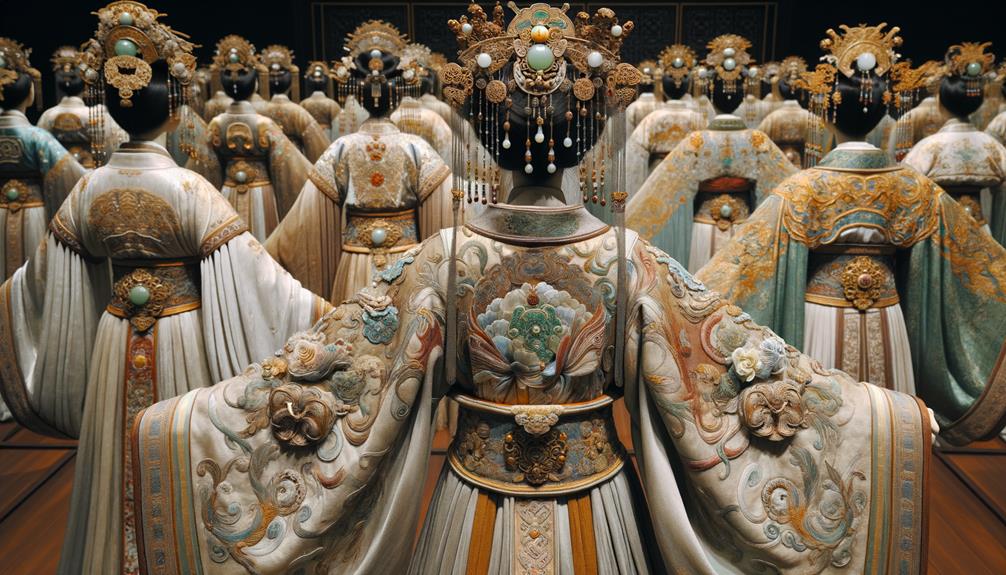
In the Qin Dynasty, clothing was more than just a means of covering oneself – it was a powerful symbol of social status, occupation, and authority. The dark hues and austere designs that dominated the era's fashion were a reflection of the emperor's strict rule and the rigid social hierarchy that defined the Qin society.
The nobility wore luxurious silk garments, a marker of their wealth and influence, while commoners wore more humble materials like hemp and cotton. This stark contrast underscored the social divide that existed during the Qin Dynasty.
Several key features defined the attire of this era. Garments were designed with functionality in mind, avoiding unnecessary adornments. The clothing worn by officials and scholars was distinct, emphasizing their roles within the social structure. Dark colors, particularly black and dark blue, were prevalent, symbolizing the authoritarian ethos of the era. The Qin Dynasty's clothing style would go on to influence the evolution of Chinese fashion in subsequent dynasties.
In essence, what someone wore in the Qin Dynasty was a silent yet profound declaration of their place in the world.
Han and Tang Dynasties
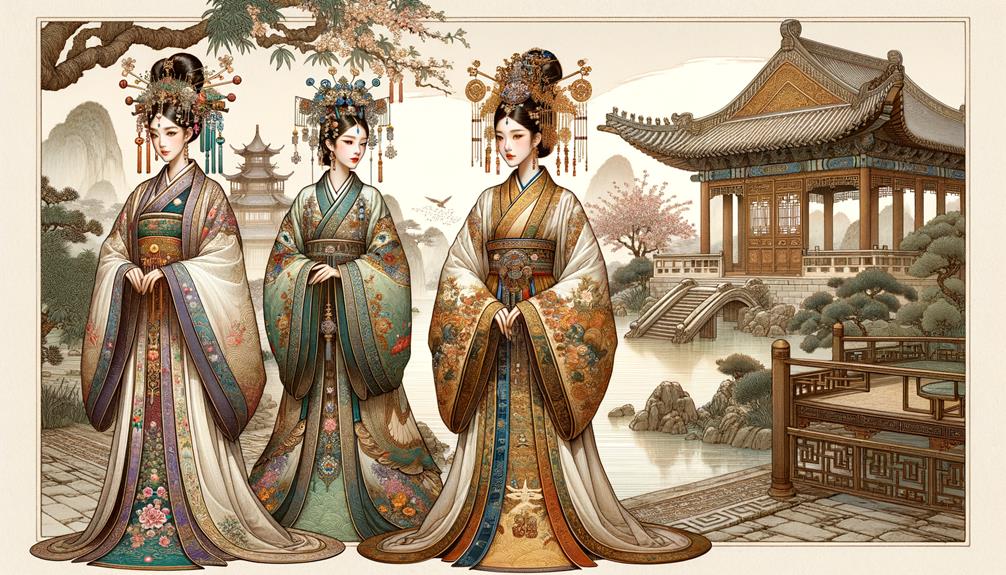
In the Han and Tang Dynasties, fashion was a vibrant tapestry of elegance and cultural expression. The clothing from these eras, characterized by wide sleeves and layered garments, reflected the refinement of ancient Chinese society. Each piece was more than just fabric; it was a statement of social status and cultural identity.
The Han Dynasty's traditional Chinese clothing was marked by simplicity and elegance, while the Tang Dynasty embraced vibrant fashion trends influenced by international trade. This blend of local and foreign elements created a unique style that still resonates today.
Here's a glimpse into the distinctive aspects of Han and Tang fashion:
| Dynasty | Style Characteristics | Cultural Significance |
|---|---|---|
| Han Dynasty | Wide sleeves, layered garments | Emphasized grace and social hierarchy |
| Tang Dynasty | Colorful, vibrant, diverse | Showcased cultural exchange and innovation |
| Both Dynasties | Elaborate hairstyles | Symbolized social status and beauty |
| Modern Impact | Inspired contemporary designs | Blends historical charm with modernity |
In both dynasties, elaborate hairstyles further accentuated personal appearance, reflecting the intricate social fabric of ancient Chinese society. Observing these fashion trends, I am struck by how they weave a narrative of elegance and cultural identity that still inspires modern interpretations.
Ming Dynasty Garments
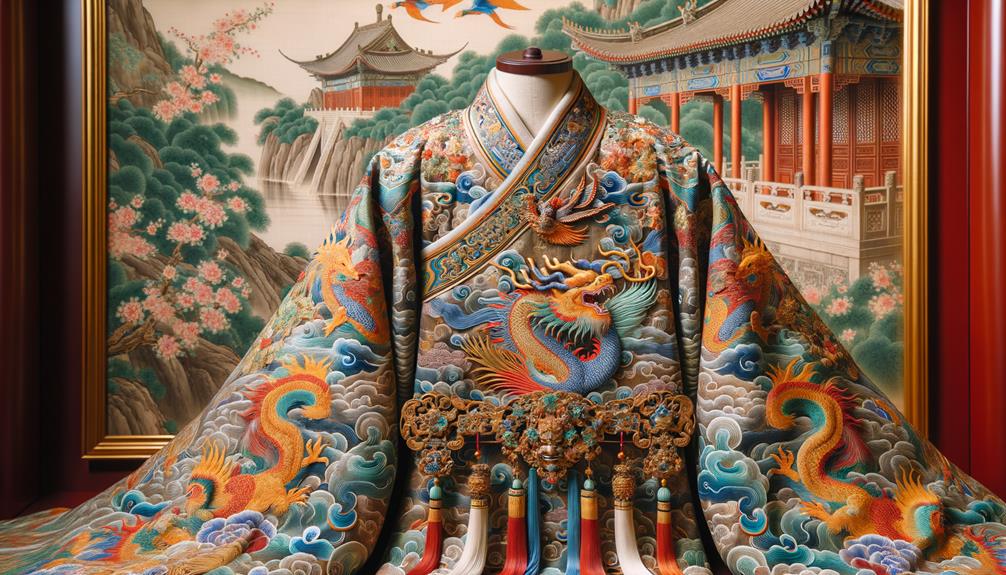
As I reflect on the exquisite garments of the Ming dynasty, I'm captivated by the intricate embroidery and symbolic patterns that adorn their opulent robes. The majestic dragon and phoenix motifs not only signify imperial power but also strike a delicate balance between the energies of Yin and Yang. It's intriguing to see how these timeless designs continue to influence modern fashion, blending ancient craftsmanship with contemporary aesthetics to create a unique fusion of old and new.
Elaborate Robes and Embroidery
The Ming dynasty's elaborate dragon robes, with their intricate embroidery, beautifully capture the delicate balance of Yin and Yang, reflecting the profound nuances of Chinese culture. As I delve into these garments, I'm struck by the meticulous craftsmanship that embodies both artistic beauty and symbolic depth. Each stitch tells a story of imperial power, prosperity, and harmony.
Rich colors and luxurious fabrics, mainly silk, envelop the wearer in an aura of opulence. The dragon robes, exclusive to the emperor, feature symbolic patterns that denote authority and celestial favor. Empresses' court robes, adorned with phoenix symbols, signify grace and feminine power, enhancing the visual and cultural tapestry of the era.
Dragon motifs represent imperial power and divine protection. Phoenix symbols signify beauty, grace, and feminine strength. Rich colors, such as crimson and gold, reflect status and wealth. Luxurious fabrics, like silk, epitomize opulence and comfort. Intricate embroidery tells stories of prosperity and harmony.
These garments are more than just clothing; they're a visual narrative of a complex and hierarchical society. The interplay of colors, patterns, and textures invites us to explore further into the rich cultural heritage of the Ming dynasty.
Influences on Modern Fashion
Drawing inspiration from the Ming dynasty's opulent dragon robes, modern fashion designers blend ancient symbolism with contemporary styles, creating a timeless dialogue between past and present. I often find myself fascinated by how these symbolic designs and rich colors, rooted in centuries-old traditions, continue to captivate and inspire today's fashion landscape.
Ming dynasty court robes for empresses, adorned with intricate phoenix symbols, offer a glimpse into a world where garments were more than mere clothing – they were powerful statements of status and prosperity. The elaborate embroidery on these robes, with its meticulous craftsmanship, tells the story of an era deeply attuned to the balance of Yin and Yang. These elements have not only survived but thrived, influencing modern fashion trends with their aesthetic and conceptual depth.
In today's fashion, the luxurious feel of embroidered silk garments echoes the grandeur of Ming dynasty attire. Designers combine traditional Chinese symbolism with contemporary styles, breathing new life into ancient motifs. The dragon robe's detailed embroidery and vibrant hues find resonance in modern collections, proving that the past's intricate craftsmanship still holds sway over our sartorial imaginations, inspiring us to blend history with innovation.
Ethnic Minority Dress
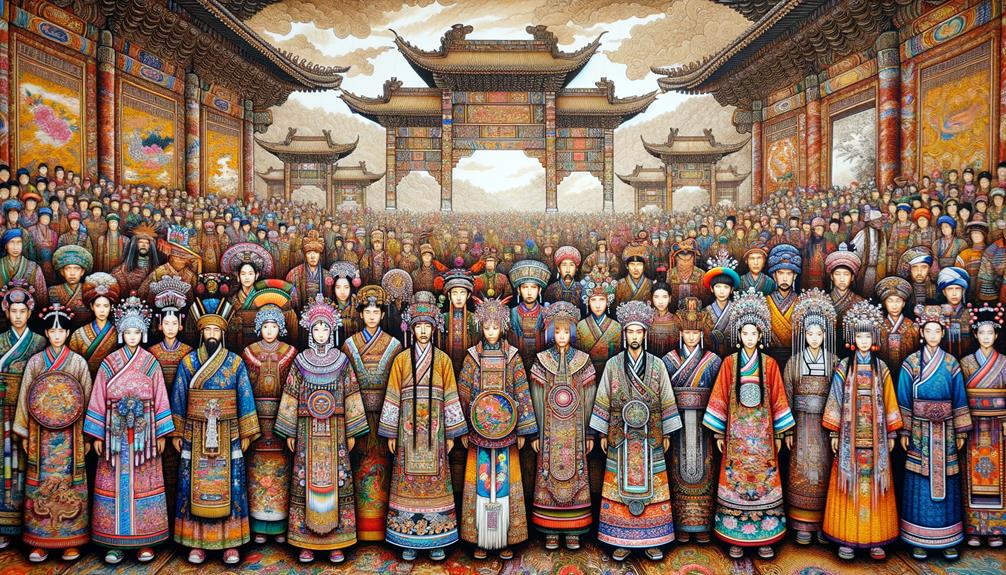
The rich cultural heritage of China's ethnic minority groups is on full display through their vibrant and diverse traditional dress. Each style tells a unique story of cultural identity, shaped by centuries of cultural exchange and blending influences from Southeast Asia, Islamic traditions, and the Silk Road.
The Dai people, for instance, wear tight-fitting shirts and narrow skirts, reflecting the Southeast Asian influences in their attire. Their colorful clothing is a testament to their connection to the tropical regions they inhabit. Tibetans, on the other hand, wear long woolen robes and elaborate headdresses, often reserved for special occasions. These garments are both practical and symbolic, reflecting a way of life shaped by the harsh, high-altitude environment.
Uyghur clothing is characterized by colorful scarves and intricate embroidery, each stitch telling a story of their rich trading history. In contrast, the Zhuang people prefer simple, earthy tones, with men typically wearing tang suits and women donning collarless jackets, emphasizing functionality and simplicity.
Traditional clothing styles among these ethnic minority groups not only preserve cultural identity but also offer a glimpse into the intricate tapestry of human history.
Dai: Tight-fitting shirts, narrow skirts
Tibetan: Long woolen robes, elaborate headdresses
Uyghur: Colorful scarves, intricate embroidery
Zhuang: Plain, earthy colors, tang suits, collarless jackets
Influences: Southeast Asian, Islamic, Silk Road
Frequently Asked Questions
What Is the Fashion Style in China?
Contemporary Chinese fashion is an intriguing blend of tradition and modernity. On the streets, trendy streetwear coexists with elegant, minimalist designs. There's a bold spirit in merging cultural heritage with global trends, creating a unique, evolving style that's both nostalgic and cutting-edge.
What Is the Traditional Clothing of China?
Imagine the flowing silks that seem to sway gently in the breeze! Traditional Chinese clothing, particularly the Hanfu, exudes elegance with its loose, comfortable fit, intricate embroidery, and flowing designs. It's a testament to the country's rich cultural heritage and timeless artistry.
When Did Fashion Start in China?
Fashion in China has a rich history spanning over 5,000 years. As I explore its evolution, I'm struck by the intricate weave of innovation and tradition that reflects the country's societal transformations and cultural richness. It's fascinating to see how history influences what we wear today.
How Does Chinese Culture Influence Fashion?
Chinese culture is a rich and intricate fabric that seamlessly weaves history into fashion. As I observe how symbolism, spirituality, and philosophical ideals are translated into garments, I'm struck by the profound impact of cultural values on modern designs, continually inspiring innovation and elegance.



